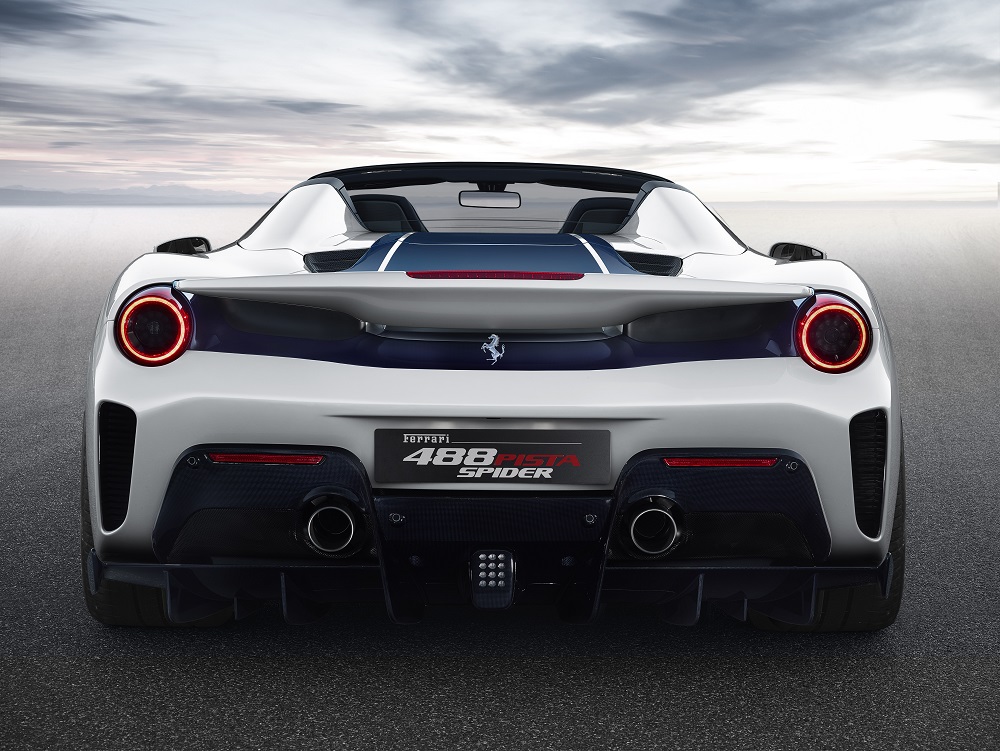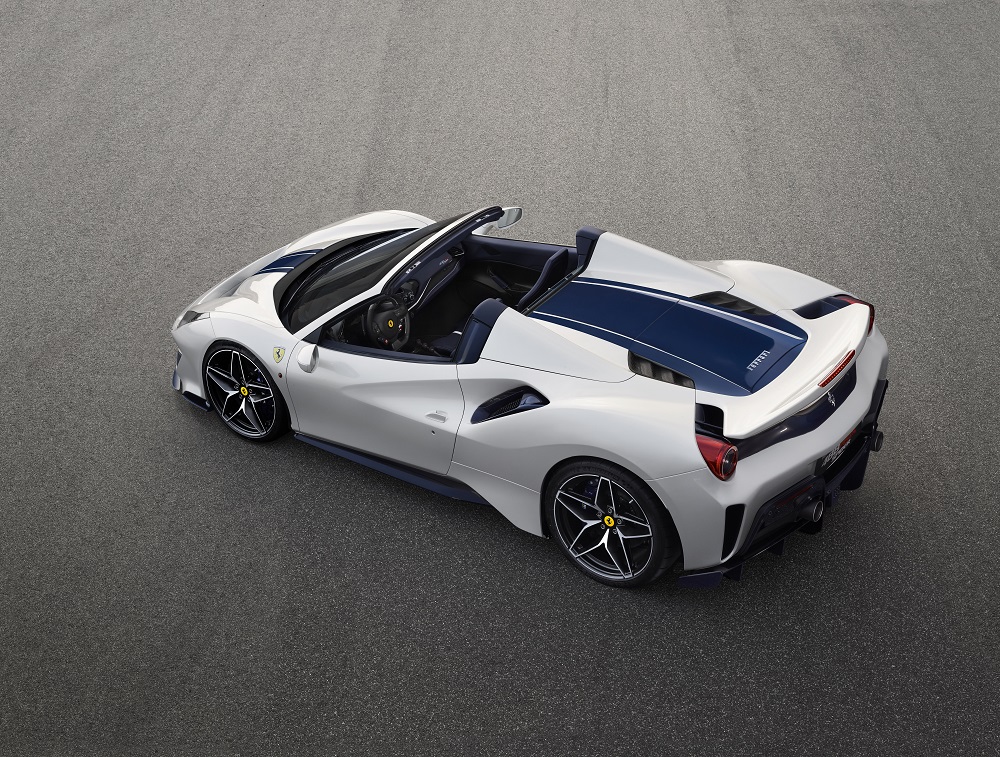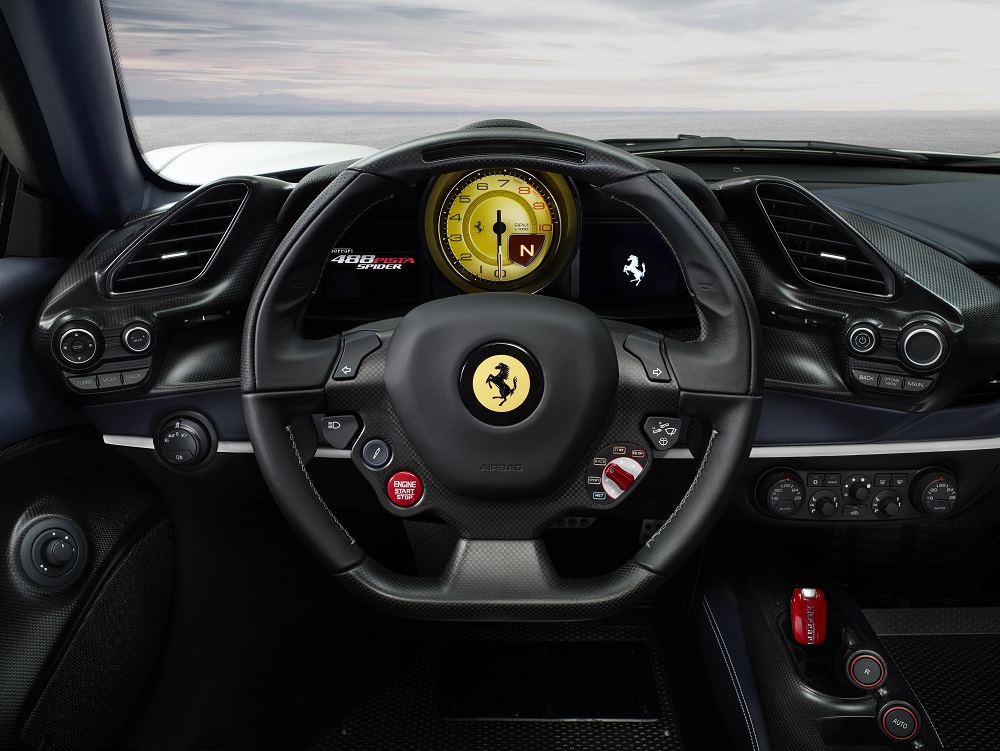Ferrari 488 Pista Spider Makes European Debut at Paris Motor Show
Transmission
The sporty driving feedback is further enhanced by the high-performance gear shifting, typical of a thoroughbred race car. The new gear shift strategy, available in the manettino’s RACE position, reduces shifting times by 30 ms.
Also adopted once again on this model is the hugely successful Ferrari Variable Torque Management strategy for all gears. To adapt it to the car’s extreme sporty spirit, all of the torque curves were redesigned to deliver a feeling of consistently smooth, powerful acceleration all the way to the red line.
Vehicle Dynamics
The aim of the Ferrari 488 Pista Spider’s dynamic development was to produce a car that offers high mechanical performance in terms of lap times and standing starts, driving pleasure and accessibility of performance to drivers of all types.
The vehicle dynamics developed for this drop-top V8 special series car thus offer a seamless combination of superb acceleration, braking efficiency, steering precision, grip, stability and handling that produces an unparalleled and genuinely immersive driving experience. This is thanks in part to the Ferrari Dynamic Enhancer (FDE) which makes controlling the lateral dynamics in high performance situations more intuitive, controllable and predictable.
To achieve these objectives, Ferrari’s engineers had to work on several fronts, starting with introducing numerous lightweight solutions as well as evolving both a new generation of the Side Slip Control System (SSC 6.0), improving the efficiency of the braking system and the introduction of new Michelin Sport Cup 2 tyres.
As was the case in the 488 Pista, the Spider features a lateral dynamics control system that uses Ferrari software to adjust the brake pressure at the callipers. The Ferrari Dynamic Enhancer (FDE) is available when the manettino is in the ‚ÄúCT-OFF‚ÄĚ position. It regulates the lateral dynamics parameters, including side slip angle estimation. The control system intervenes in advance, lightly actuating the callipers through, and exiting corners.
As a result the system manages the evolution of the side slip angle, making control of the lateral dynamics in high-performance situations more intuitive, controllable and predictable. So it is not a stability control system, but a maximum performance-focused system.
The introduction of the Ferrari Dynamic Enhancer into the integrated SSC 6.0 system thus gives drivers extra confidence so that they can more easily handle even lengthy oversteer situations. It also makes performance on the limit easier to reach and control even for less expert drivers.
The Ferrari 488 Pista Spider is extremely efficient in dealing with rapid changes of direction and offers drivers a unique sense of predictability. The recalibrated SCM-E dampers and the 10% stiffer springs contribute to this improved handling precision. Longitudinal acceleration is 13% higher than on the 488 Spider.
Although the 488 Pista Spider was developed for mostly road use, it was also designed to deliver impressive performance on the track. As a result, the braking system was modified to improve cooling, particularly under extreme use, and also to cut the time it takes to get up to temperature.
The 488 Challenge’s brake servo was adopted to enhance the sporty pedal feel and deliver smooth, consistent braking even in extreme conditions. These interventions, combined with the car’s lighter overall weight, have reduced the 200-0 km/h stopping distance by a metre compared to the 488 Spider.
The bodyshell was designed to keep the car as light as possible and features ultralight materials such as carbon-fibre for the engine cover, the front and rear bumpers and the rear spoiler, and Lexan for the rear window.
This is also the first time that an optional 20‚ÄĚ single-piece carbon-fibre wheel rim has been made available in the Ferrari range. Made entirely from carbon-fibre, it is around 20% lighter than the forged wheel rims that come as standard on this car and features a special coating developed for the aerospace industry on the channel and spokes which efficiently reflects and dissipates heat generated under braking.
Aerodynamics
In-depth aerodynamics research played a big part in improving the Ferrari 488 Pista Spider’s performance. Working on a concept focused on uncompromising innovation and performance allowed considerable engineering freedom in developing significant solutions.
The already-exceptional aerodynamic efficiency of the 488 Spider has been improved by 20%, with major benefits in terms of absolute speed and lap times on medium-fast tracks as well as sheer fun behind the wheel.
This substantial improvement is due in great part to the radical choices made for the bodywork and underbody forms with the aim of increasing downforce without increasing the car’s drag coefficient.
In fact, the 488 Pista Spider takes the aerodynamic concepts adopted on the 488 Spider from which it is derived and moulds them into a much more technically extreme and ambitious package. Examples are the active aerodynamics on the rear underbody and a completely redesigned version of the blown spoiler (patented on the 488 GTB).
The 488 Pista Spider‚Äôs V8 turbo punches out 50 cv more than the car on which it is based, thanks in part to a reduction of almost 15¬į C in the temperature of the air entering the plenum with respect to the 488 Spider. The development of the thermo-fluid dynamics consequently focused on powertrain cooling, to minimise any impact on pure aerodynamic performance.
To guarantee the kind of performance demanded of the powertrain, the intercooler would have required an increase of over 25% in size compared to that of the 488 Spider. In order to minimise the increase in weight and drag associated with such a large radiating surface, the engineers worked intensively on the car as a whole to improve efficiency, limiting the required surface area increase to just 7%. The main contributing factors to the improved intercooler efficiency were the radical layout choices made at the front of the car.
The front radiator arrangement was completely redesigned. As with 488 Challenge, the rake of the radiators has been inverted and they are now inclined towards the rear to direct the hot air to the underbody ahead of the front wheels. This choice produced, on the one hand, an improvement of 10% in the performance of the rear intercoolers, and, on the other, an additional aerodynamic benefit: the virtual fairing of the exposed area of the tyre which cuts the car’s drag by 7%.
The engine air intakes have been moved from the flanks ‚Äď the solution adopted on the 488 Spider ‚Äď to the rear spoiler as per the 488 Challenge. The specific shape of the spoiler delivers powerful recompression which guarantees that the engine air intake benefits from high dynamic pressure, shortening the length of the inlet duct, reducing consequent losses and boosting engine performance.
The need for efficient downforce resulted in the whole of the front of the car being completely redesigned, particularly the bumpers and bonnet. One innovative Formula 1-derived solution in particular stands out: the S-Duct. The air from the intake on the front bumper passes through an aerodynamic duct with calibrated sections and exits through a vent on the bonnet, creating downforce over the front axle.
Furthermore, the front intake is completed by a central lower wing profile with a dual function. On the one hand, it acts as a splitter which, thanks to its curvature, accelerates the flow and increases the amount of air passing through the S-Duct, thus improving its performance while, on the other, it creates a low pressure area under the front underbody, further boosting downforce.
The introduction of this particular solution accounts for 18% of the overall increase in downforce compared to the 488 Spider, but barely a 2% increase in drag.
The exterior sections of the bumper ahead of the wheels were also extensively redesigned with solutions modified from the 488 Challenge and reinterpreted so successfully that they are responsible for 23% of the increase in downforce compared to the 488 Spider. Radical scoops in the front bumper allow aerodynamic elements to protrude in areas where they can be most efficient. The volume of the front bumper is recessed before the wheel-arch to deflect the flow ahead of the wheels outwards, generating suction from the wheel-arch and thus from the front underbody, which is equipped with diffusers, all to the benefit of front downforce.
At the rear, two elements contributed to the achievement of the downforce target: the blown spoiler system and the venting behind the rear wheels.
The spoiler is higher (+30 mm) and longer (+40 mm) compared to its counterpart on the 488 Spider. Development work focused on the efficiency of the bleed under the spoiler. In fact, the evolution of the spoiler system and its bleed has had a significant impact on downforce, accounting for 25% of the overall increase compared to the 488 Spider.
As is always the case with each new Ferrari, the car’s underbody was specifically redesigned to ensure it delivers as efficient a downforce figure as possible. The first major difference from the 488 Spider is how the hot air from the radiators is deflected to the underbody ahead of the front wheels. This choice, made to enhance the cooling layout and lower the car’s drag coefficient, however shrinks the surfaces that can be used to generate downforce. To make up for this and further boost downforce, the designers decided to exploit other areas of the underbody.
The Ferrari 488 Pista Spider was thus equipped with front diffusers, made possible by the change in the inclination of the front radiators and the elimination of the dams ahead of the wheels. Thanks to a ramp already optimised for the 488 GTE, the diffusers accelerate the flow, venting it into the wheel-arches, creating strong suction that in turn is responsible for 12% of the overall downforce increase compared to the 488 Spider.
The vortex generators on the underbody have also been optimised and now generate 10% more downforce, thanks to modifications to their profile and length.
The rear diffuser is also derived directly from Ferrari‚Äôs World Endurance Championship experience and has the same double kink line as the 488 GTE‚Äôs, amplifying the extraction and downforce generation capacities of a traditional diffuser. As in the 488 GTB, the diffuser is equipped with a system of 3 active flaps which rotate 14¬į in minimum drag configuration to completely stall the diffuser and thus significantly reduce the car‚Äôs drag.



